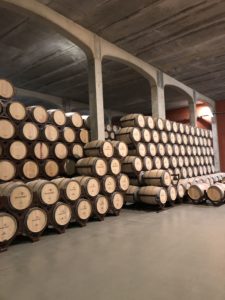Wine Cellar

A wine cellar is a storage room for wine in bottles or barrels, or more rarely in carboys, amphorae, or plastic containers. In an active wine cellar, important factors such as temperature and humidity are maintained by a climate control system. In contrast, passive wine cellars are not climate-controlled, and are usually built underground to reduce temperature swings.
An above ground wine cellar is often called a wine room, while a small wine cellar (fewer than 500 bottles) is sometimes termed a wine closet. The household department responsible for the storage, care and service of wine in a great mediaeval house was termed the buttery. Large wine cellars date back over 3700 years.
Wine can be stored satisfactorily between 7–18 °C (45–64 °F) as long as any variations are gradual. A temperature of 13 °C (55 °F), much like that found in the caves used to store wine in France, is ideal for both short-term storage and long-term aging of wine. Note that wine generally matures differently and more slowly at a lower temperature than it does at a higher temperature. When the temperature swings are significant, 14 degrees or more, it will cause the wine to breathe through the cork which significantly speeds up the aging process. Between 10–14 °C (50–57 °F), wines will age normally. Wine cellars protect alcoholic beverages from potentially harmful external influences, providing darkness, constant temperature, and constant humidity.
Wine is a natural, perishable food product issued from fermentation of fruit. Left exposed to heat, light, vibration or fluctuations in temperature and humidity, all types of wine can spoil. When properly stored, wines not only maintain their quality but many actually improve in aroma, flavor, and complexity as they mature. Depending on their level of sugar and alcohol, wines are more or less sensitive to temperature variances; wine with higher alcohol and/or sugar content will be less sensitive to temperature variance






